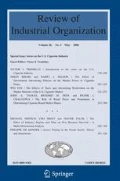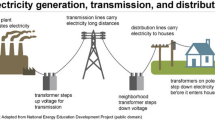Abstract
During 2014–2015, the Antitrust Division achieved enforcement successes in a wide range of matters. Many, such as the case against American Express, played out publicly in court proceedings. But two of the Division’s most significant investigations over the past year involved mergers that the parties abandoned in the face of concerns that were expressed by the Division. In each of these mergers, economic analysis played an important role in understanding their likely impact on competition. This article provides a sample of the types of issues that have been raised in recent antitrust cases that did not, ultimately, end up on the public record.
Similar content being viewed by others
Notes
See, e.g., Nevo (2014).
Press Statement, Comcast, “Time Warner Cable to Merge with Comcast Corporation to Create a World-class Technology and Media Company,” February 13, 2014. Available at: http://corporate.comcast.com/news-information/news-feed/time-warner-cable-to-merge-with-comcast-corporation.
Press Statement, Comcast, “Comcast/Time Warner Cable/Charter Transactions Terminated.” Available at: http://corporate.comcast.com/news-information/news-feed/comcast-twc-charter-transactions-terminated.
Press Statement, Comcast, February 13, 2014, supra.
Liana B. Baker, “Comcast takeover of Time Warner Cable to Reshape U.S. Pay TV,” Reuters, February 13, 2014. Available at: http://www.reuters.com/article/2014/02/13/us-comcast-timewarnercable-idUSBREA1C05A20140213. And Press Statement, Comcast, February 13, 2014, ibid.
Liana B. Baker, February 13, 2014, ibid.
Emily Steel, “Comcast’s Track Record in Past Deals May be Hitch for Merger with Time Warner Cable,” New York Times, April 21, 2015. Available at: http://www.nytimes.com/2015/04/22/business/media/6-senators-urge-rejection-of-comcast-time-warner-cable-deal.html?_r=0.
Liana B. Baker, February 13, 2014, supra.
When we discuss the video market we mean the market for the timely delivery of professional, full-length video programming to residential customers. When we discuss the broadband market we mean the market for the provision of fixed broadband Internet access services to residential customers.
As discussed below, in the programming market, programmers contract with cable, satellite, and telephone companies and online video distributors to distribute their video content. In the interconnection market, Internet content providers contract with Internet service providers (ISPs) to distribute their content.
Many content providers arrange for delivery of their content by contracting with other firms that directly interconnect with ISPs and provide other services. In some cases a content provider will deliver content to consumers on a network with which it is not directly connected by having a second network provide “transit service”—carrying the traffic across the second network and through that network’s interconnection to the destination. This approach is not favored by many video and other content providers for whom delivery delay can be costly, because transit may be more susceptible to congestion.
Higher interconnection fees are not inherently harmful to consumers. Indeed, in some circumstances, higher interconnection fees could be necessary to ensure optimal investment in interconnection facilities. The increase due to a merger’s change in bargaining leverage, though, is not likely correlated with such beneficial circumstances. Indeed, as the later discussion of video and broadband markets will illustrate, the potential for indirect harm from this increased leverage was particularly acute in this case.
This empirical work is described in detail in Arons and Raskovich (forthcoming).
Lower programming fees, all else equal, can be beneficial in that some portion of them would likely be passed on to consumers. However, the lower programming fees actually represent an increase in leverage, and this leverage can be used to extract other contract terms for which the interests of the merged entity and consumers would not be aligned. In light of the video and broadband market considerations that are discussed below, it is unlikely that an increase in bargaining power for the merged entity would, on net, have benefitted consumers.
Press Release, Applied Materials, “Applied Materials and Tokyo Electron to Combine, Creating a New Global Innovator to Serve the Semiconductor and Display Industries,” Sept. 24, 2013. Available at: http://www.appliedmaterials.com/company/news/press-releases/2013/09/applied-materials-and-tokyo-electron-to-combine-creating-a-new-global-innovator-to-serve-the-semiconductor-and-display-industries.
The process steps are completed in a “chamber”. Many chambers are often assembled on a “mainframe” that mechanically moves the silicon wafers between chambers.
Moore (2006).
Press Release, ASML, “ASML Completes Acquisition of Cymer,” May 30, 2013. Available at: http://www.asml.com/asml/show.do?ctx=5869&rid=48841. Press Release, Lam Research, “Lam Research and Novellus Systems to Combine in $3.3 Billion All-Stock Transaction,” December 14, 2011. Available at: http://investor.lamresearch.com/releasedetail.cfm?releaseid=633499.
Press Release, Applied Materials, “Applied Materials, Inc. and Tokyo Electron Limited Agree to Terminate Business Combination Agreement,” April 26, 2015. Available at: http://www.appliedmaterials.com/company/news/press-releases/2015/04/applied-materials-inc-and-tokyo-electron-limited-agree-to-terminate-business-combination-agreement.
The Lam Research Corp. is a remaining large competitor, which has significant capabilities in developing etch and some deposition tools in competition with AMAT and TEL.
See http://www.appliedmaterials.com/product-library and http://www.tel.com/product/index.htm for descriptions of AMAT’s and TEL’s products.
Applied Materials spent over $1.4 billion on R&D in FY2014. See Press Release, Applied Materials, “Applied Materials Announces Fourth Quarter and Fiscal Year 2014 Results.” Available at: http://www.appliedmaterials.com/company/news/press-releases/2014/11/applied-materials-announces-fourth-quarter-and-fiscal-year-2014-results. TEL spent over $750 million on R&D in FY2014. See Tokyo Electron Annual Report 2014. Available at: http://www.tel.com/ir/library/ar/document/ar2014_all.pdf, p. 2.
Renata Hesse in Press Release, U.S. Department of Justice Antitrust Division, “Applied Materials Inc. and Tokyo Electron Ltd. Abandon Merger Plans After Justice Department Rejected Their Proposed Remedy,” April 27, 2015. Available at: http://www.justice.gov/opa/pr/applied-materials-inc-and-tokyo-electron-ltd-abandon-merger-plans-after-justice-department.
References
Arons, R., & Raskovich, A. (Forthcoming). Do bigger firms get better terms? Content licensing in pay TV. Economic Analysis Group, Antitrust Division, U.S. Department of Justice.
Moore, G. (2006). Chapter 7: Moore’s law at 40. In Brock, D. (Ed.), Understanding Moore’s law: Four decades of innovation. Chemical Heritage Foundation. http://www.chemheritage.org/Downloads/Publications/Books/Understanding-Moores-Law/Understanding-Moores-Law_Chapter-07.pdf.
Nevo, A. (2014). Mergers that increase bargaining leverage. Remarks as Prepared for the Stanford Institute for Economic Policy Research and Cornerstone Research Conference on Antitrust in Highly Innovative Industries. http://www.justice.gov/atr/speech/mergers-increase-bargaining-leverage. 22 January 2014.
Author information
Authors and Affiliations
Corresponding author
Rights and permissions
About this article
Cite this article
Hill, N., Rose, N.L. & Winston, T. Economics at the Antitrust Division 2014–2015: Comcast/Time Warner Cable and Applied Materials/Tokyo Electron. Rev Ind Organ 47, 425–435 (2015). https://doi.org/10.1007/s11151-015-9490-z
Published:
Issue Date:
DOI: https://doi.org/10.1007/s11151-015-9490-z




